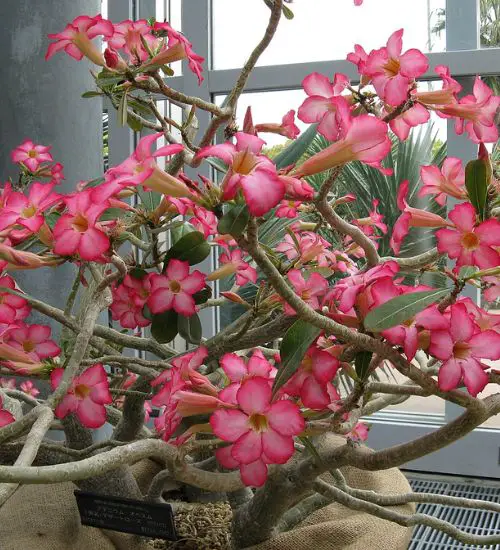Sun: full sun
Water: Typical water needs for a succulent
Temperature: Zone 11a from 40° F to 45° F (4.4 ° C to 7.2° C)
Winter Survival: Not cold hardy
Propagation: cuttings, seeds
Flower: in the Spring or Summer
Flower Type:
Toxic: Can be toxic to humans and animals
Dormant: winter
Space Requirement: Indoors & Outdoors
Common Problems: Plants may rot if overwatered, pests
Where to buy Adenium Obesum?
Basc Care for Adenium Obesum
Watering
Regular watering period should be every 2 weeks
One simple tip for you is that you can use some online apps to check the soil status before you go water your succulents. I would recommend the ThePlantsCheck app, it has some nice features there.
Fertilizing
Only feed this succulent during its active growing seasons which means winter. Use the right fertilizer applied in the right amounts. Applying half-strength balanced fertilizer every month or so is recommended for optimal results.
Do not fertilize during winter as the plant is dormant.
Sun & Location Requirements for "Desert Azalea, Desert Rose, Impala Lily, Kudu Lily, Mock Azalea, Sabi Star"
Adenium Obesum needs at least six hours of direct sunlight every day in order to be healthy and happy. Place your succulent outdoors or near a sunny window, and check its leaves regularly – they should be bright green and firm. If the leaves start to look weak or pale, it's an indication that the succulent isn't getting enough sun.
Adenium Obesum is not cold hardy and does not survive in freezing conditions. However, there are certain strategies that can be used to help the plant thrive despite the chill of winter. Proper drainage and insulation are essential for succulent X during periods of extreme cold. Placing a layer of mulch or gravel on the soil around the plant can also help keep it warm.
Adenium Obesum also benefits from some indirect light throughout the day as well, so make sure you give it enough space to soak up light without becoming too exposed to heat.
Propagation
One way to propagate Adenium Obesum is by cutting
Adenium Obesum propagates easily from seeds, however it's important to look for healthy ones which are plump, dark in color and slightly sticky when touched. To start the propagation process, mix a soil mixture with well-draining potting mix then sow the seeds evenly and press them lightly into the surface. Finally, water the soil using a spray bottle and place it in bright but indirect light to ensure germination.
Toxicity

Although it may be tempting to grow Adenium Obesum due to its beautiful flowers and vibrant colors, it is important to be aware of the potential dangers associated with this succulent. Ingesting any part of the plant can cause serious health complications. If you are considering growing it, make sure you take all necessary safety precautions and consult a professional if necessary.
Pests and Diseases
Adenium Obesum can be affected common pests and diseases like most of the other succulents such as aphids, mealybugs, scale insects, and Red spider mites.
If you do spot any of pest signs, you can treat your succulent using below methods.
- Aphids: quarantine, clean infected plants, soapy water.
- Mealybugs: quarantine, clean infected plants, soapy water.
- Scale insects: quarantine, clean infected plants, soapy water.
- Red spider mites: Quarantine, clean your infected plants, treatment with a systemic insecticidal/soapy water.
Besides that, to prevent serious health issues from happening, keep your succulent in a well-ventilated area and check it regularly for any signs of pests or health problems.


